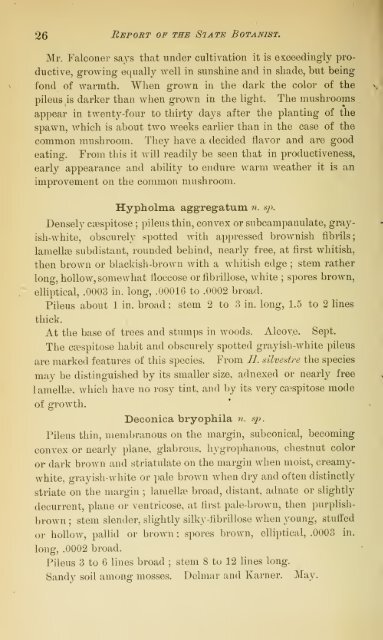Annual Report of the State Botanist 1892 - MykoWeb
Annual Report of the State Botanist 1892 - MykoWeb
Annual Report of the State Botanist 1892 - MykoWeb
You also want an ePaper? Increase the reach of your titles
YUMPU automatically turns print PDFs into web optimized ePapers that Google loves.
26<br />
<strong>Report</strong> <strong>of</strong> <strong>the</strong> 8iate <strong>Botanist</strong>.<br />
Mr. Falconer sa3's that under cultivation it is exceedingly pro-<br />
ductive, growing equally well in sunshine and in shade, but being<br />
fond <strong>of</strong> warmth. When grown in <strong>the</strong> dark <strong>the</strong> color <strong>of</strong> <strong>the</strong><br />
pileus is darker than when grown in <strong>the</strong> light. The mushrooms<br />
appear in twenty-four to thirty days after <strong>the</strong> planting <strong>of</strong> <strong>the</strong><br />
spawn, which is about two weeks earlier than in <strong>the</strong> case <strong>of</strong> <strong>the</strong><br />
common mushroom. They have a decided flavor and are good<br />
eating. From this it will readily be seen that in productiveness,<br />
early appearance and ability to endure warm wea<strong>the</strong>r it is an<br />
improvement on <strong>the</strong> common mushroom.<br />
Hypholma aggregatum n. sj).<br />
Densely csespitose ; pileus thin, convex or subcampanulate, gray-<br />
ish-white, obscurely spotted with appressed brownish fibrils<br />
lamellae subdistant, rounded behind, nearly free, at first whitish,<br />
<strong>the</strong>n brown or blackish-brown with a whitish edge ;<br />
stem ra<strong>the</strong>r<br />
long, hollow, somewhat lioccose or fibrillose, white ; spores brown,<br />
elliptical, .0003 in. long, .00016 to .0002 broad.<br />
Pileus about 1 in. broad ; stem 2 to 3 in. long, 1.5 to 2 lines<br />
thick.<br />
At <strong>the</strong> base <strong>of</strong> trees and stumps in woods. Alcov.e. Sept.<br />
The cjespitose habit and obscurely spotted grayish-white pileus<br />
are marked features <strong>of</strong> this species. From B. silvestre <strong>the</strong> species<br />
may be distinguished by its smaller size, adnexed or nearly free<br />
1 amellse, which have no rosy tint, and by its very caespitose mode<br />
<strong>of</strong> growth.<br />
Deconica bryophila n. sp<br />
Pileus thin, membranous on <strong>the</strong> margin, subconical, becoming<br />
convex or nearly plane, glabrous, hygrophanous, chestnut color<br />
or dark brown and striatulate on <strong>the</strong> margin when moist, creamy-<br />
white, grayish-white or pale brown when dry and <strong>of</strong>ten distinctly<br />
striate on <strong>the</strong> margin ;<br />
lamellae broad, distant, adnate or slightly<br />
decurrent, plane or ventricose, at first pale-brown, <strong>the</strong>n purplish-<br />
brown ;<br />
stem slender, slightly silky -fibrillose when young, stuffed<br />
or hollow, pallid or brown ; spores brown, elliptical, .0003 in.<br />
long, .0002 broad.<br />
Pileus 3 to 6 lines broad ;<br />
stem 8 to 12 lines long.<br />
Sandy soil among mosses. Delmar and Karner. May.<br />
.<br />
;
















